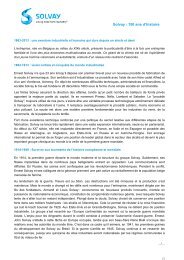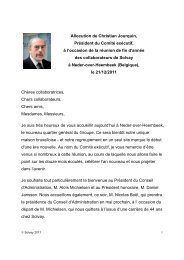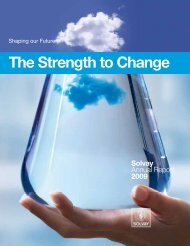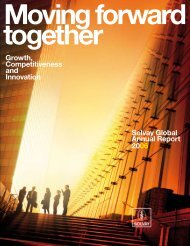solvay_live243_p02a04 somEdito
solvay_live243_p02a04 somEdito
solvay_live243_p02a04 somEdito
You also want an ePaper? Increase the reach of your titles
YUMPU automatically turns print PDFs into web optimized ePapers that Google loves.
Dossier SolvayInnovationTrophy2006<br />
20<br />
The lighting market is under heavy pressure from<br />
an invasion of Chinese products. How do we<br />
react to such a situation? How can we protect our<br />
know-how? Should we relocate? Innovation<br />
is central to Philips Lighting’s response.<br />
Innovating<br />
to stay up front<br />
Lighting life has changed 360 degrees in<br />
recent years”, was Klaas Vegter's opening shot. “The<br />
good old days when Philips, General Electric and<br />
Osram together shared 70% of the world lighting<br />
Philips<br />
“At<br />
products market between them are long since gone”, the Chief<br />
Technology Officer of the Lamps business group told Solvay live.<br />
The shock came from the Far East. For the past fifteen years,<br />
Chinese companies have been flooding the lighting market (incandescent<br />
and TL lamps) with lower quality but very cheap products.<br />
“They penetrate the market through major retail chains”, Klaas<br />
Vegter explains. “So we set up shop in China where we produce certain<br />
low energy consumption lamps – real ‘commodity’ products –<br />
whilst improving their quality to maintain our brand value.”<br />
Protecting one’s know-how<br />
Philips Lighting, on the other hand, protects its mainstream business.<br />
“Office lighting, industrial lighting and street lighting are sectors<br />
where longevity, quality and reliability are still criteria of choice.<br />
In certain environments it is an expensive job replacing blown lamps!”<br />
There’s no question of know-how transfer or cooperation with<br />
China. “Here we jealously guard our know-how”, Klaas Vegter warns.<br />
But competition is not just about products. New technologies have<br />
irrupted into the lighting market, totally changing the entry barriers<br />
to the profession. Semiconductors were foreign to the Philips culture.<br />
Today, Taiwan alone has hundred of companies which together<br />
can feed the entire world market with light-emitting diodes (LEDs,<br />
OLEDs). Philips’ response to this situation was to acquire<br />
Californian LED producer Limuleds. “Diode production is still marginal<br />
to our main business. However, we cannot rule out that one day<br />
we will need diodes in our traditional applications, where we want<br />
LED die (Light Emitting Diode).<br />
to remain present.” Semiconductor technology is so different,<br />
though, from that of traditional lighting, that the two worlds live<br />
their own separate lives at Philips.<br />
Innovating to maintain a lead<br />
It is in traditional lighting that Philips remains leader. Here too<br />
though, the Dutch company is feeling the growing pressure from<br />
China. “We will remain the best only if we maintain our lead”,<br />
Klaas Vegter acknowledges. The research department is first of<br />
all confronted with a question of internal organization and recognition<br />
of its true mission, see-sawing between “obligatory<br />
service” to the operating units that finance its research projects,<br />
and its need to pursue a longer-term vision, by definition of less<br />
immediate interest to the operating units. Greater financial<br />
autonomy was the first necessary step. “15% of our budget is now<br />
devoted to long-term projects. I’m careful to make sure we do not<br />
take on missions that are really the job of the operating units. I’m<br />
putting my team back on the track of their real profession, that of<br />
finding new ideas. Each team member is given 5% of his or her time<br />
to explore new avenues, with bonuses for success! This has redynamized<br />
my team.” Klaas Vegter has also demanded that each<br />
team that is developing a new idea construct a demonstration




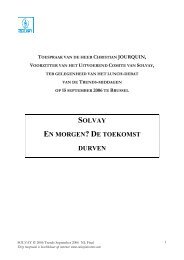
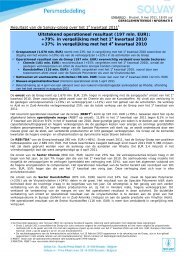

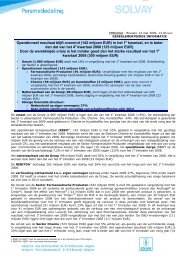
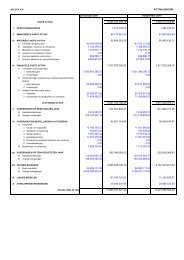

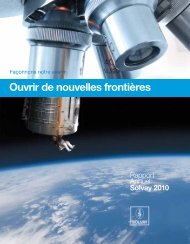
![PROC.1 [LETTRE] - Solvay](https://img.yumpu.com/16585746/1/184x260/proc1-lettre-solvay.jpg?quality=85)
